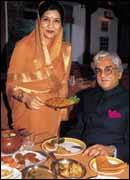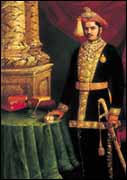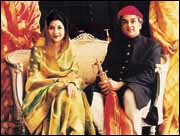


 Gaekwadi Gharana Khana
Gaekwadi Gharana KhanaThe cuisine of the royal palace of Baroda has been influenced by the princesses who married into the ruling Gaekwad family of this city, writes MAHARANI SHUBHANGINIRAJE GAEKWAD. |
|
PAINTINGS and food, these are subjects of great interest at the Laxmi Vilas Palace of Baroda. You get any member of the royal Maratha Gaekwad family of this city of Gujarat to talk about art and gastronomy, and they will tell you stories that could fill books. In fact, several have been written already. And they are preserved with great care in the palace museum. I think it runs in the Gaekwad family's blood, this fascination for paintings and food. My husband, Maharaja Ranjitsinghji Gaekwad, the chairman and managing trustee of the Maharaja Fatesingh Museum of Baroda, is a collector of art and a gourmet of food. His father was a great cook and his elder brother almost came out with a cookery book. So, you see...
But there is good enough reason for this unusual heritage. Maharaja Sayajirao III, my husband's great-grandfather who ruled Baroda between 1875 and 1939, was a great connoisseur of arts and food. He had the legendary portraitist Raja Ravi Varma of Kerala come and execute a series of mythological paintings for the newly-constructed Laxmi Vilas Palace in 1888. What a contrast these paintings made to
It is true that Gaekwadi cuisine is unique, you will not find in anywhere in India. In fact, not even outside the Laxmi Vilas Palace! I believe it is the earliest version of fusion cooking in the country. Maharaja Sayajirao III, a great gourmet and entertainer, was quick to realise this. He saw that the food had evolved because it had been influenced by princesses of the Gwalior, Tanjore and Kolhapur gharanas, and also other states, who had married into the Gaekwad family. These princesses, and a succession of chefs with different cooking styles, changed the original Maratha cuisine of the Baroda palace to suits their tastes. What had developed was being identified as "Gaekwadi" food by those lucky enough to sample it. And a proud Maharaja Sayajirao III decided to present it to the world through books.
I'm afraid, Gaekwadi food did not really take off the way Maharaja Sayajirao III wanted it to. Which is why we, Maharaja Ranjitsinghji Gaekwad and I, would like to revive the concept and let it be known nationally to start with. Then take it to the world. Nothing much has changed in the food. The royal kitchen in the palace is smaller than what it was during Maharaja Sayajirao III's time. He was extravagant, he had one cook making one dish! And the Gaekwad family continues to be one of hearty eaters. Vegetarians dining at the palace are amazed at the variety of non-veg food. There's very little for them! Some element of meat, fish or eggs is added even to simple vegetarian fare to create new delicacies. We even have a non-vegeterian undhiyu! This is a fine example of fusion cooking. Undhiyu is a Gujarati dish, but to the fresh vegetables and masalas cooking in a mud pot over a slow fire, we add chicken, boiled eggs and dumplings of kheema. That's non-veg undhiyu!
The Baroda palace cooks have all perfected the unique Gaekwadi food recipes. They even make their own masala to go with the cuisine. It is called Kala Masala and it is more "garam" than the ubiquitous garam masala. Thirty spices go Kala Masala and a lot of coconut. It is roasted, fried and stored twice a year, but never during the monsoon. Our lunch in the palace is Indian, and dinner always Continental. Indian food, especially Gaekwadi cuisine, is too rich to have twice a day. Besides, we are fond of Continental food. Our cooks make Continental meals that are comparable to the best in classic French restaurants. You should taste the tartare sauce they make. It is unique. It goes so well with a roast saddle of lamb. When we are dining abroad, we often wish we had carried our own tartare sauce with us!
Finally, the 25 cookery books. The man who wrote them out was Maharaja Sayajirao III's kitchen in-charge, Narayan Kadam. He did an inimitably marvellous job. The books are compendiums for anybody interested in Gaekwadi food. He wrote them in Urdu, English and Tamil, and later translated them into Marathi, because the earliest influences on Gaekwadi food were from Continental, Mughlai, Bengal and South Indian cuisines. He's described Gaekwadi cooking methods and recipes. And provided menus: for sit-down dinners and garden parties; to serve 1,000 people and for a single diner; for an entire month with not a single dish repeated. He's written on foods meant for religious and festive occasions, and for illnesses. And on how cooks are to be trained, what ingredients they must use, how to indent food, what service they must provide, and what silver and china go with what meal. Plus, guides on storing foods, and books on kitchen administration.
Like I said, Maharaja Sayajirao III's cookery books and Raja Ravi Varma's paintings are part of the heritage of the Gaekwad family. They can be seen in the Maharaja Fatesingh Museum of the Laxmi Vilas Palace in Baroda. Slowly but surely, Gaekwadi food will also be known. Right now, it is known only to our cooks. But we certainly don't want the cuisine to be lost. It is all right to keep family secrets closed, but surely, something as unique and exciting as a cuisine that exists only in the old stone walls of a 19th century palace deserves to be brought out. And shared.
|

Home Page
About the mag
Subscribe
Advertise
Contact Us
 the Indo-Saracenic architecture of the palace.
Today, they are the single largest collection of Raja Ravi Varma's works in the world. Maharaja Sayajirao III, who believed good food led to good health and a good life, also commissioned 25 books on the unique Gaekwadi cuisine that was being made in the traditional kitchen of the palace. Like the paintings, these books are part of the Gaekwad family's heritage.
the Indo-Saracenic architecture of the palace.
Today, they are the single largest collection of Raja Ravi Varma's works in the world. Maharaja Sayajirao III, who believed good food led to good health and a good life, also commissioned 25 books on the unique Gaekwadi cuisine that was being made in the traditional kitchen of the palace. Like the paintings, these books are part of the Gaekwad family's heritage.
 The men in the Gaekwad family are all very knowledgeable about food, but they seldom cook. We entertain a lot. We have a variety of friends, people who love good food, and people conscious of diets. A healthy balance! We organise sit-downs and buffets. And we are always happy to try new foods. I suppose, we have eaten everything! We love to go eating out in London. You get all kinds of food there, from pure Gujarati to the most exotic western cuisines. Even game! At one time, game food was big at the palace. Wild boar, partridge, peacock, duck, now everything is banned. Partridge and hare have the run of our gardens. The Laxmi Vilas Palace cooks still have recipes for game food. There are three cooks, all trained in-house. No, they don't refer to cookery books at all. Not even Maharaja Sayajirao III's books. Gaekwadi food is routine for them. They all know how to make it.
The men in the Gaekwad family are all very knowledgeable about food, but they seldom cook. We entertain a lot. We have a variety of friends, people who love good food, and people conscious of diets. A healthy balance! We organise sit-downs and buffets. And we are always happy to try new foods. I suppose, we have eaten everything! We love to go eating out in London. You get all kinds of food there, from pure Gujarati to the most exotic western cuisines. Even game! At one time, game food was big at the palace. Wild boar, partridge, peacock, duck, now everything is banned. Partridge and hare have the run of our gardens. The Laxmi Vilas Palace cooks still have recipes for game food. There are three cooks, all trained in-house. No, they don't refer to cookery books at all. Not even Maharaja Sayajirao III's books. Gaekwadi food is routine for them. They all know how to make it.